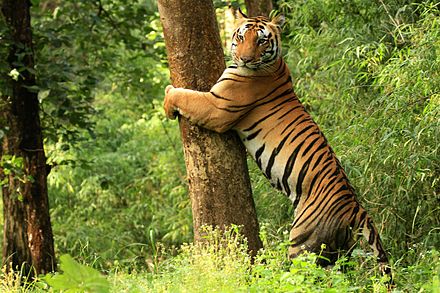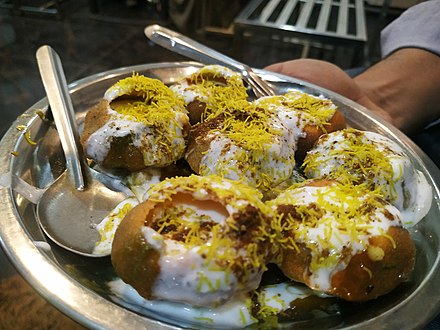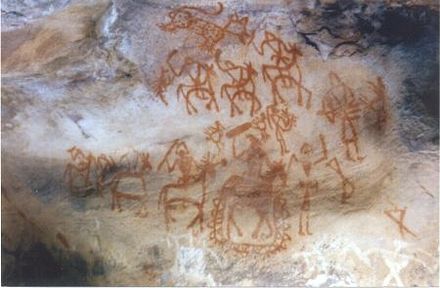Madhya Pradesh - state in central India
Madhya Pradesh (commonly abbreviated as MP) is a state in the plains of India. The name "Madhya Pradesh" means "central region", and derives from its geographical position. It is one of the few states of India that is completely surrounded by other states, having neither a border with another country nor a coastline. To its north is Uttar Pradesh. To its west lie Rajasthan and Gujarat, to its south is Maharashtra and to its east is Chhattisgarh, a state that used to be a part of MP till 2000.
MP has been rather neglected as a travel destination, but in reality, it has a rich feast for those who seek prehistoric paintings, historic forts, religious erotica, or tribal culture. On the flip side, the tourist infrastructure is not very well-developed.
Regions
Bhopal-Narmadapuram Division (Betul, Bhopal, Harda, Hoshangabad, Raisen, Rajgarh, Sehore, Vidisha)
Northern Madhya Pradesh (Ashok Nagar, Bhind, Datia, Guna, Gwalior, Morena, Sheopur, Shivpuri)
Western Madhya Pradesh (Agar Malwa, Dewas, Mandsaur, Neemuch, Ratlam, Shajapur, Ujjain, Alirajpur, Barwani, Burhanpur, Indore, Dhar, Jhabua, Khandwa, Khargone)
Jabalpur-Sagar Division (Balaghat, Chhindwara, Jabalpur, Katni, Mandla, Narsinghpur, Seoni, Dindori, Chhatarpur, Damoh, Panna, Sagar, Tikamgarh, Niwari)
Eastern Madhya Pradesh (Rewa, Satna, Sidhi, Singrauli, Anuppur, Shahdol, Umaria)
{{mapshape|type=geoshape|fill=|title=Bhopal-Narmadapuram Division|wikidata=Q1815279, Q1797245, Q2173003, Q620801, Q1815223, Q1833306, Q2299029, Q1815253}} {{mapshape|type=geoshape|fill=|title=Northern Madhya Pradesh|wikidata=Q2246416, Q2341700, Q2206266, Q930027, Q2085310, Q2341467, Q620105, Q2299042}} {{mapshape|type=geoshape|fill=|title=Western Madhya Pradesh|wikidata=Q15732396, Q2025998, Q1870014, Q2341713, Q2299164, Q2449803, Q892641, Q2667586, Q2126754, Q2125592, Q742938, Q2299069, Q2085336, Q2085436, Q2273900}} {{mapshape|type=geoshape|fill=|title=Jabalpur-Sagar Division|wikidata=Q641904, Q1986096, Q632093, Q746441, Q2341670, Q2341616, Q2221184, Q2398551, Q2341630, Q2085421, Q2449760, Q63563797, Q2479331, Q2449785}} {{mapshape|type=geoshape|fill=|title=Eastern Madhya Pradesh|wikidata=Q526862, Q2577924, Q2449793, Q2668638, Q2299093, Q2085464, Q620297}}
Cities
Here are nine of the most notable cities.
-
Bhedaghat 📍 — home to the Marble Rocks, about which many have rhapsodised
-
Jabalpur 📍 — ancient city in on the shores of the holy river Narmada and the tributary plains of the Hiran, Gour, Ken and Sone rivers
-
Sagar 📍 — a university city with a number of forts, temples, lakes and waterfalls
-
Satna 📍 — a small town, home to the Sharda Mata temple (at Maihar) and peaceful surroundings
-
Ujjain 📍 — city of Shree Mahakaleshwar Temple (Jyotirlinga) with many temples to visit
Other destinations

-
Bandhavgarh National Park 📍 — among the best national parks of India where Asian tigers can be easily viewed
-
Bhimbetka 📍 — a UNESCO World Heritage site noted for its cave paintings
-
Kanha National Park 📍 — beautiful and well managed park containing a good number of wildlife species
-
Madhav National Park 📍 — has forested hills and grasslands around Chandpatha (an artificial lake) that is home for a variety of deer, leopard and sloth bear. It provides a winter home for many migratory birds. Within the park stands the George Castle.
-
Mandla Plant Fossils National Park 📍 — this park boasts fossilized plants 40-150 million years old as well as scattered fossilized molluscs
-
Panna National Park 📍 — a national park and tiger reserve
-
Pench National Park 📍 — has various species of animals such as deers, wild gaurs and monkeys with infrequent sightings of tigers and lions
-
Sanjay National Park 📍 — part of the Sanjay-Dubri Tiger Reserve, is a forested habitat for the tiger, leopard, porcupine and a large diversity of birds
-
Satpura National Park 📍 — in the rugged terrain of the Satpura hills, this park habitat for a large diversity of animals.
Understand
Madhya Pradesh is the central part of India. Madhya Pradesh originally became a state on 1 November 1965. In 2000, the southeast portion of Madhya Pradesh was split off and became the state of Chhattisgarh. For the entirety of its history, the capital has been Bhopal. Madhya Pradesh has four other major cities in addition to Bhopal which are Indore, Gwalior, Jabalpur and Ujjain. It is divided into many divisions, fifty districts and two hundred blocks. Before Madhya Pradesh was divided, the population was 60,385,118 (India census 2001). The geographical area is 4,434,459 km.
In ancient times Vairisimha II was the king and the capital was Ujjain. When King Bhoj became king he moved the capital to Dhar. During the independence war, Fort Dhar played an important part in the fight for freedom and produced many freedom fighters. Many tribes played an important role like the Bhils, Rajpurohit and Rajput.
Madhya Pradesh has many large tribes and castes. Tribal groups inhabit the Vindhya mountain range areas of the state. Probably the best-known local clan are the Rajputs, the traditional landlords in the area.
Madhya Pradesh, also called Green Malaw, is the breadbasket of India. Eighty percent of the population depends on agriculture. Wheat, corn, peas, grain, cotton and soybeans are the most important crops. Many dense forests are important resources of timber, providing bamboo, teak and sal. The state is also full of natural resources, including coal, iron and diamonds. The state is also well known for its handicrafts.
Talk
Hindi is the main language used. English knowledge can sometimes be found inside the cities. Do not expect anyone to speak English outside the main cities.
Get in
Get around
See
- Bandhavgarh National Park - Madhya Pradesh has the highest density of tigers in the world, and it's one of few places where you are almost certain of seeing a tiger in its natural habitat.
- Khajuraho - Khajuraho is world-famous for its erotic Tantric temple complexes.
Do
Eat


As elsewhere in Central India, you can have the delicacies of regional cuisines from all over India in Madhya Pradesh. Besides, local Central Indian cuisine (Malwi food) is delicious: local Poha, and Daal Baflae of certain places such as Ujjain Indore and Ratlam are delicious.
- Ratlam is famous place for Namkeen Sev.
- The street food of Indore is renowned, with shops that have been active for generations, famous for Butta Kees and even Sabudana Khichdi available around the clock. Do visit the Sarafa Bazar and Chappan Dukkan for the local delicacies available in the city and don't forget to enjoy the usal pohwa and pure desi ghee jalebies.
- Bhopal is known for meat and fish dishes, such as rogan josh, korma, keema, biryani, pilaf, and kebabs. There is street named "Chatori Gali" in old Bhopal where one can find traditional Muslim non-veg fare such as Paya soup, Bun Kabab, Nalli-Nihari and other local specialities.
- Gwalior is famous for chaat named as Bedmi (dal stuffed suji puri with aloo ki teekhi sabji), a favorite morning breakfast of gwaliorites, and also a famous sweet named Gajak (from Morena), famous in winter season, made up of Seasme and Jaggery, said to be very good for health also.
- Dal bafla is a common meal in the region, consisting of a steamed and grilled wheat cake dunked in rich ghee which is eaten with daal and ladoos. The culinary specialty of the Malwa region of central Madhya Pradesh is poha (flattened rice); usually eaten at breakfast with jalebi.
